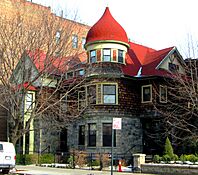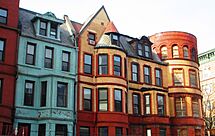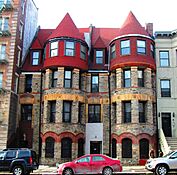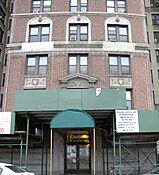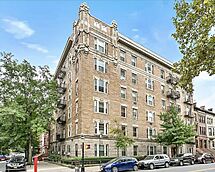Sugar Hill, Manhattan facts for kids
|
Sugar Hill Historic District
|
|
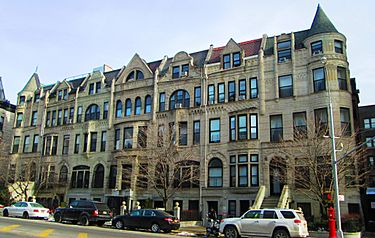
row houses at 718-730 St. Nicholas Avenue (2014)
|
|
| Location | Roughly bounded by W. 155th St., 145th St., Edgecombe Ave. and Amsterdam Ave. Manhattan, New York |
|---|---|
| Area | 75 acres (30 ha) |
| Built | 1883-1930 |
| Architect | Richard S. Rosenstock, Arthur Bates Jennings, Frederick P. Dinkelberg, Henri Fouchaux, Theodore Minot Clark, Neville & Bagge, Schwartz & Gross, George F. Pelham, Horace Ginsbern, C. P. H. Gilbert, Clarence True, John P. Leo, Samuel B. Reed, William Grinnell, William Schickel et al. |
| Architectural style | Queen Anne, Romanesque Revival, Renaissance Revival, Beaux-Arts, Neoclassical, Colonial Revival, Gothic Revival, neo-Grec, etc. |
| NRHP reference No. | 02000360 |
Quick facts for kids Significant dates |
|
| Added to NRHP | April 11, 2002 |
Sugar Hill is a special neighborhood in Manhattan, New York City. It is known for its rich history and beautiful buildings. This area is part of the Harlem and Hamilton Heights neighborhoods.
Sugar Hill is officially recognized as a National Historic District. This means its buildings and history are protected. The area is bordered by West 155th Street to the north and West 145th Street to the south. Edgecombe Avenue is to the east, and Amsterdam Avenue is to the west.
The neighborhood was added to the National Register of Historic Places in 2002. It includes 414 important buildings, two sites, three structures, and one object that contribute to its historical value.
The Story of Sugar Hill
Sugar Hill got its name in the 1920s. It became a popular place for wealthy African Americans to live. This was during the Harlem Renaissance, a time when Black art and culture thrived. The name "Sugar Hill" came from the "sweet life" people enjoyed there.
Many famous African Americans lived in its beautiful rowhouses. These included important leaders like W. E. B. Du Bois and Thurgood Marshall. Musicians like Duke Ellington and Cab Calloway also called Sugar Hill home. Other notable residents were Walter Francis White, Roy Wilkins, Sonny Rollins, and Arturo Schomburg.
Langston Hughes, a famous writer, described the neighborhood in 1944. He wrote about the nice apartment buildings on Sugar Hill. He mentioned that families there sent their children to private schools. This showed how well-off some residents were.
Terry Mulligan wrote a book in 2012 called Sugar Hill, Where the Sun Rose Over Harlem. It shares her experiences growing up in the neighborhood in the 1950s and 1960s. She lived near future Supreme Court Justice Thurgood Marshall. She also knew music legend Frankie Lymon and baseball star Willie Mays.
Famous Buildings in Sugar Hill
Sugar Hill has many interesting and historic buildings. Here are some of the most well-known:
- Nicholas C. and Agnes Benziger House, at 345 Edgecombe Avenue. This building was designed by William Schickel in 1890–91. It has been used as a hospital, a nursery, and even housing for people experiencing homelessness.
- James A. and Ruth M. Bailey House, at 10 St. Nicholas Place. Built in 1886–88, this grand home was for James A. Bailey. He was famous for the Barnum & Bailey Circus. It is built in the Romanesque Revival style.
- The Garrison Apartments, 435 Convent Avenue. Designed by Neville & Bagge in 1909-1910, it was first called Emsworth Hall. In 1929, it became a cooperative apartment building. It is the oldest continuously operated co-op in New York City that was founded, owned, and managed by Black people. Many important Harlem trailblazers lived here.
- 14 and 16 St. Nicholas Place. These detached houses were built in 1883–84 by William Grinnell. They are in the Queen Anne style and are covered in wood shingles.
- Fink House, at 8 St. Nicholas Place. This Queen Anne style house was built in 1885 by Richard S. Rosenstock.
- Baiter House, at 6 St. Nicholas Place. Built in 1893–94 by Theodore G. Stein. It was later combined with the Fink House. Together, they were used as a sanitarium, a hospital, a hotel, and a group home.
- 713-721 St. Nicholas Avenue. These row houses were built in 1890–1891 by Hugh M. Reynolds. They show the Victorian Romanesque Revival style.
- 718-730 St. Nicholas Avenue. This row of buildings was designed by Arthur Bates Jennings in 1889–1890. It is also in the Romanesque Revival style.
- 729 and 731 St. Nicholas Avenue. These two houses were built in 1886 by Theodore Minot Clark. They are faced with Manhattan schist stone and shingles.
- 757-775 St. Nicholas Avenue. Designed by Frederick P. Dinkelberg in 1894–1895. This row of buildings is in the Renaissance Revival style. It is considered one of the finest in the district.
- 409 Edgecombe Avenue Apartments. Built by Schwartz & Gross in 1916–1817, these were originally called the Colonial Parkway Apartments. Famous residents included Babe Ruth (as an infant), artist Aaron Douglas, and Supreme Court Justice Thurgood Marshall.
- 555 Edgecombe Avenue. Many famous big band leaders lived here in the 1940s. These included Count Basie, Andy Kirk, Don Redman, and Duke Ellington's bandmate Cootie Williams.
Gallery
See also
 In Spanish: Sugar Hill (Manhattan) para niños
In Spanish: Sugar Hill (Manhattan) para niños




